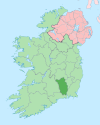Ballyragget
Ballyragget
Béal Átha Ragad | |
|---|---|
Town | |
 The 15th century Ballyragget Castle overlooks the town | |
| Coordinates: 52°47′00″N 7°20′00″W / 52.783333°N 7.333333°W | |
| Country | Ireland |
| Province | Leinster |
| County | County Kilkenny |
| Population | 1,082 |
| Time zone | UTC+0 (WET) |
| • Summer (DST) | UTC-1 (IST (WEST)) |
Ballyragget (Irish: Béal Átha Ragad, meaning "Mouth of Ragget's Ford")[2] is a small town on the river Nore in the north of County Kilkenny in Ireland. Ballyragget is on the N77 18 km (11 mi) north of Kilkenny. As of the 2016 census, it had a population of 1,082 people.[1]
Toponymy[edit]
The name 'Ragget' is Anglo-Norman in origin, and denotes a once-prominent Norman landowner Richard le Ragget who held these lands in the early part of the 13th century.
Older names of the settlement include Donoughmore (or Donaghmore; Irish: Domhnach Mór "large church") and the even more ancient Tullabarry (Irish: Tualach Bare) - the name of a Celtic or possibly pre-Celtic tribe which held their seat in the vicinity. There is some debate as to the meaning of Donoughmore. The very first issue of the Journal of the Kilkenny Archaeological Society (January 1948), which has an article about Ballyragget and its environs, states a belief that Domhnach Mór means "big Sunday" and relates to the fact that thousands of people congregated at the now ruined church in Donoughmore for its opening on a Sunday and the name stuck.[3]
History[edit]
The settlement of Ballyragget originally formed at a fording-point on the River Nore at this location.[4] Originally named after the 13th century Anglo-Norman landowner Richard le Ragget, Ballyragget was later held by Mountgarret family.[4] The town is dominated by a large medieval keep (known as Ballyragget Castle). It is five storeys in height and surrounded by a court or bawn which has round defensive towers in each of four corners. A moat originally surrounded the keep and bawn, but now this can only be seen outside the north wall.[5] This tower was renovated in the late 15th century, and contains a late 16th century inscribed stone which commemorates Edmund Butler, 2nd Viscount Mountgarret.[4]
Much of the town streetscape was laid out by George Butler and his grandson Robert Butler around the town's square in the mid-17th century.[4][6] A large mid 19th-century Catholic church sits on a rise overlooking the town's central square.[7]
Geography[edit]
The River Nore flows beside the town, which nestles in a wide alluvial valley between the Attanagh Plateau and several hills to the east, including 'Knockmannon' and 'The Balla boys'. The Nore passes by one of the most significant ancient sites in North Kilkenny 5 kilometres (3.1 mi) south of Ballyragget at Rathbeagh. The statistical Ballyragget Geographical Area is recorded by the CSO as containing 26.67 square kilometres (10.30 sq mi).
To the north lies the town of Durrow in County Laois, to the south the River Nore flows on towards Kilkenny City.
The town is located in the townland of the same name which is in the civil parish of Donoghmore in the ancient barony of Fassadinin.[8]
Demographics[edit]
Central Statistics Office reports indicate that Ballyragget's population increased by over 30% in the 20 years between the 1996 census and the 2016 census of Ireland, from 803 to 1,082 inhabitants.[1][9]
The electoral division which surrounds the town had a population of 1,451 in the 2006 census.[citation needed]
The majority of residents in Ballyragget are nominally Roman Catholic, although there are minority Protestant and non-religious populations.[1]

Economy[edit]
Agriculture and the agri-food industry are the largest employers, with the large Tirlán factory across the river dominating the town's industry for the past forty years. The plant at Ballyragget is the largest multi-purpose integrated dairy plant in Europe, and both Glanbia plc and Tirlán can trace their roots to the Avonmore co-operative founded in Ballyragget in the 1960s.[10]
A percentage of the area's residents commute to work (or education) some distance from the town.[1]
Education[edit]
Ballyragget is served by Ballyragget National School was opened following the amalgamation of Scoil Naomh Bhríde and Scoil Chiaráin Naofa in August 2018.[11] There is no secondary school in the town.
Politics[edit]
At national level, Ballyragget, as part of the Carlow–Kilkenny constituency, is represented by five Teachtaí Dála in Dáil Éireann.
At a local level, the town is within the administrative area of Kilkenny County Council.[12]
People[edit]
- Mabel Cahill, a champion tennis player who won the U.S. Open and held the singles, doubles and mixed titles for 1891–1892, was born in Ballyragget[13]
See also[edit]
References[edit]
- ^ a b c d e "Sapmap Area - Settlements - Ballyragget". Census 2016. Central Statistics Office. April 2016. Retrieved 14 January 2020.
- ^ "Béal Átha Ragad / Ballyragget". logainm.ie. Irish Placenames Commission. Retrieved 14 January 2020.
- ^ "Old Kilkenny Review". Journal of the Kilkenny Archaeological Society (1). January 1948.
- ^ a b c d Ballyragget Local Area Plan 2004 (PDF). kilkennycoco.ie (Report). Kilkenny County Council. p. 2.
- ^ Lyng, T. "Ballyragget and District" (PDF). Kilkenny Archaeological Society. Retrieved 18 June 2023.
- ^ Lyng, T. "Ballyragget and District" (PDF). Kilkenny Archaeological Society. Retrieved 18 June 2023.
- ^ "Saint Patrick's Catholic Church, Ballyragget, County Kilkenny (1842)". buildingsofireland.ie. National Inventory of Architectural Heritage. Retrieved 14 January 2020.
- ^ "Townland of Ballyragget (Béal Átha Ragad)". Irish Placenames Commission. Retrieved 14 January 2020.
- ^ "Ballyragget (Ireland) Census Town". City Population. Retrieved 14 January 2020.
- ^ "Our story". tirlaningredients.com. Retrieved 24 February 2023.
- ^ "Ballyragget National School". Ballyragget National School. Retrieved 18 June 2023.
- ^ "Ballyragget Local Area Plan". kilkennycoco.ie. Kilkenny County Council. Retrieved 14 January 2020.
- ^ O'Callaghan, Eoin. "The Mystery and Tragedy of Mabel Cahill". The 42. Retrieved 13 November 2019.
Further reading[edit]
- Lewis, Samuel (1837). A Topographical Dictionary of Ireland. London: S. LEWIS & Co. 87, Aldergate Street.


